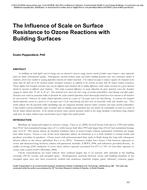Description
As buildings are built tighter and air change rates are lowered to conserve energy, passive control of indoor ozone becomes a more important factor for indoor environmental quality. Heterogeneous reactions between ozone and indoor building materials have been extensively studied in chambers, which have resulted in varying deposition velocities for similar materials. The removal of ozone to surfaces requires the transport of the ozone from the bulk air to the material surface (transport resistance) in addition to the reaction of ozone with the surface (surface resistance). Theory implies that transport resistance may vary for different sized chambers due to airflow differences, while surface resistance of a given material should be constant in different sized chambers. This study examined differences in ozone deposition for given materials across five chambers ranging in volume from 35 mL to 22 m³. Two materials were chosen for their range of reaction probabilities: vinyl flooring and office paper. Materials were coated in potassium iodide to determine the surface limited deposition, which theoretically should have been constant in all chambers for each material. However, the surface limited deposition varied by a factor of 5 for paper and 2 for vinyl flooring. In contrast, the transport limited deposition varied by a factor of 2.1 for paper and 1.9 for vinyl flooring and there were no observable trends with chamber size. These results indicate that the potassium iodide methodology may not adequately determine material surface resistance and ozone reaction probabilities. Using chamber reaction probability values to predict room or building ozone deposition may over predict the consumption of ozone by a factor of two for surface limited materials. If the amount of passive ozone removal materials needed in low energy buildings is determined using chamber study data, the indoor ambient ozone concentrations may be higher than models predict.
Citation: IAQ Conference: IAQ 2013: Environmental Health in Low Energy Buildings
Product Details
- Published:
- 2013
- Number of Pages:
- 6
- File Size:
- 1 file , 1.6 MB
- Product Code(s):
- D-2013IAQConf-45




